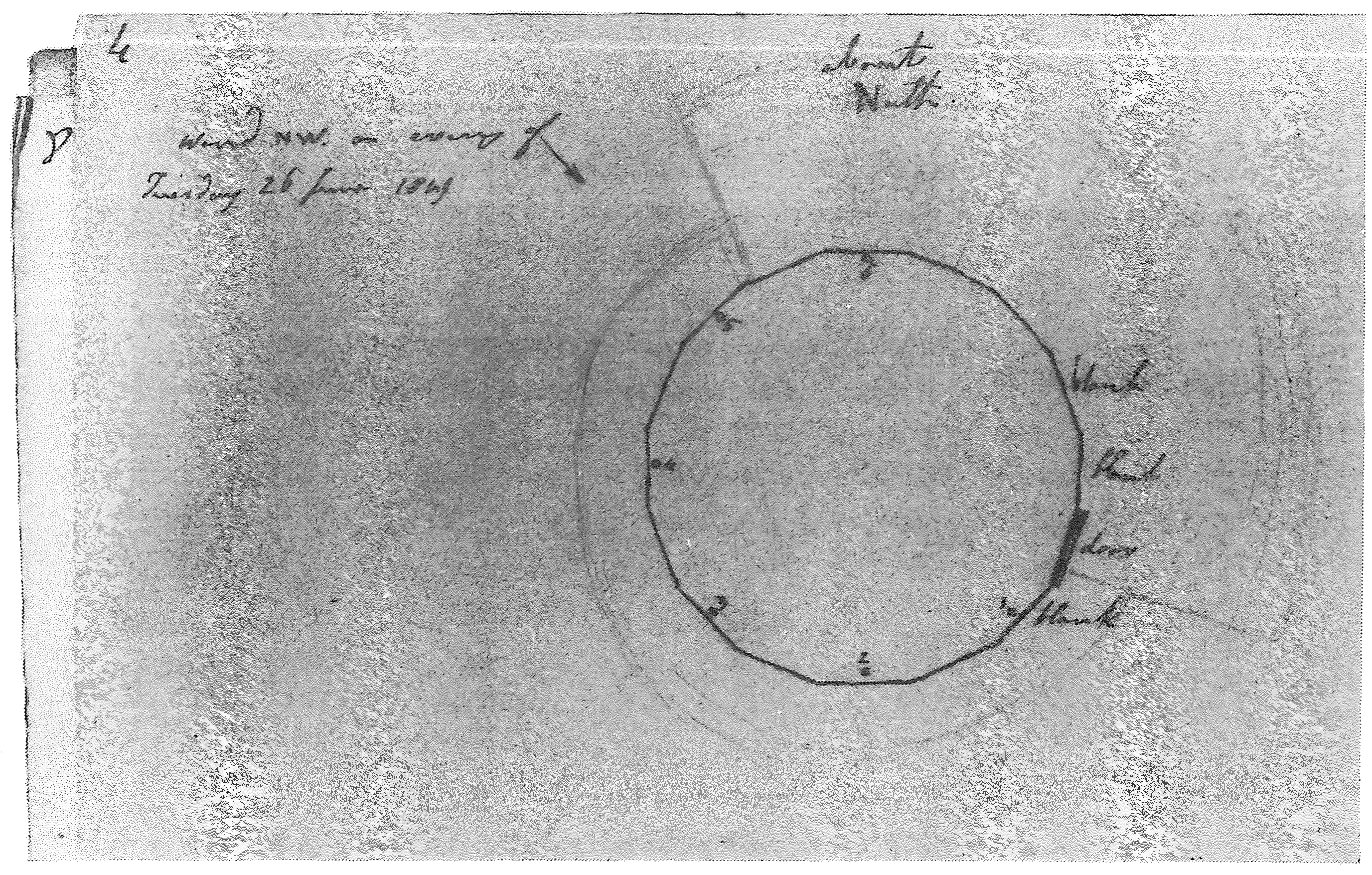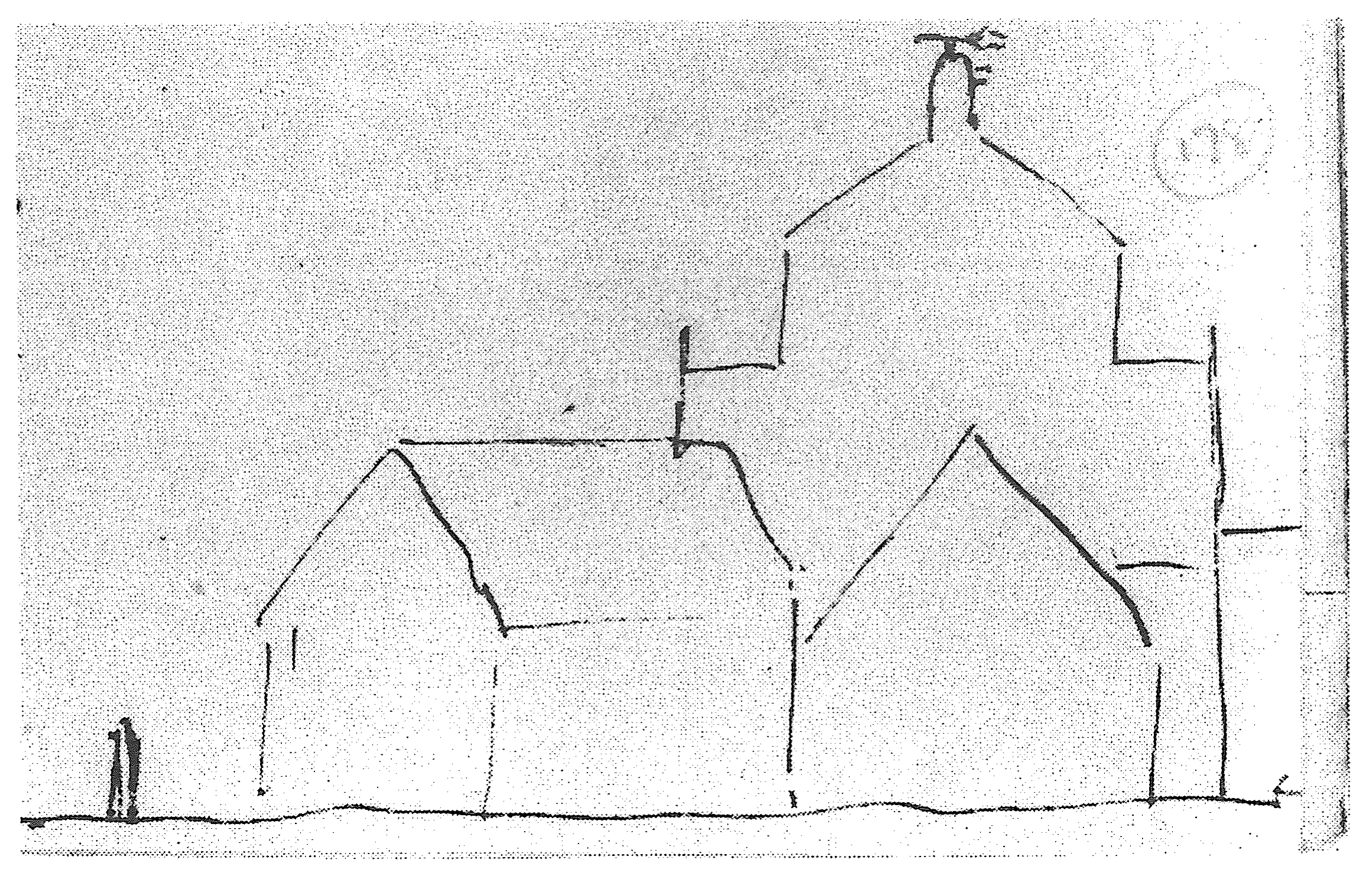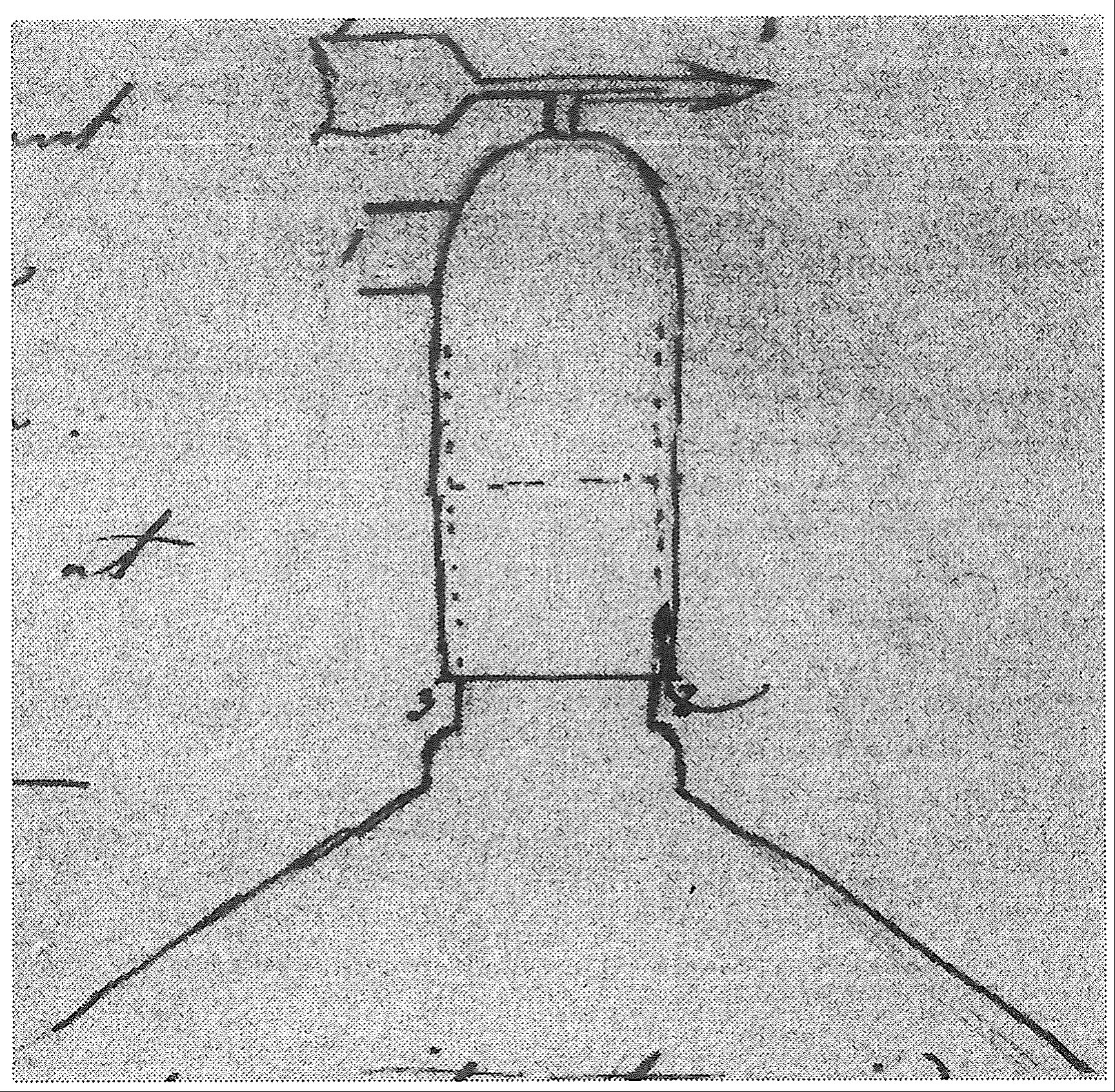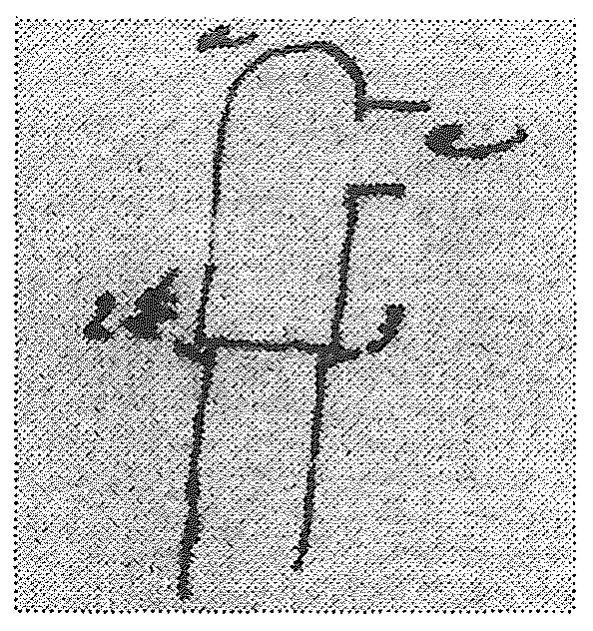Faraday to Jacob Herbert 30 June 1849
Royal Institution | 30 June 1849.
My dear Sir
I started on Monday morning (25th instant) going to the Dungeness and Needles lighthouses and returned on Wednesday night; and now proceed to give you the results of my visit, which I hope was not in vain1.
Arriving at Dungeness lighthouse about two hours before sunset, I found, upon enquiry, that the evil which had presented itself was not the deposition of moisture upon the glass or any part within the lanthorn, for in that respect the keeper reported that the ventilating apparatus answered perfectly: - but, that when the lamps were all alight then, at certain of them, from two to four in number according to the wind &c there was a return of air down the ventilating pipes which would occasionally disturb the flames and sometimes extinguish them. After carefully examining the draught at each separate pipe and also in & about the cowl, I came to the conclusion that this was due, not to deficiency of general ventilation but to some obstruction of the lamp ventilation, of such a nature as to make it insufficient for the whole number of lamps (eighteen); so that when all were alight a part of the burnt air ascending from the flames, being unable to pass away above, returned down those tubes which had the weakest ascensive power and thus established as it were for the time a returning syphon action.
Upon this view I proceeded to examine in detail the upper part of the apparatus, and found that one of the deflector plates had been set so low as to approximate over much to the aperture beneath it, and was likely enough to cause obstruction sufficient to account for the effect observed. Thinking there was time before sunset, by vigorous exertion, to correct this state of things; and being well aided by the keeper & assistant keeper; we dismounted the upper part of the apparatus, and by means of a carpenters chisel & a pair of pincers, cut away three pieces from the copper tube so as to make the aperture beneath the deflector plate double what it had been before, and then restored all to its place. This was done before sunset; and upon the lamps being lighted I had the satisfaction of finding that every one drew well; that there was an indraught at the top of each glass; and that all parts seemed to work harmoniously together instead of being in opposition to each other. Such was the case all night long. The keepers, also, were conscious of the difference of action from the first moment of lighting and expected good results; the wind changed in the night, and rose at one time considerably without producing any ill effect. I believe that the evil is entirely remedied; nevertheless I shall be glad to hear the results in a week or two, and accordingly left instructions with the keeper to report the state of things to you shortly.
The next morning I started for the Needles lighthouse but could not reach it before 9 o clk at night. I found this to be a very different case from the former; for the keepers here made no complaint respecting the burning of the lamps: but on the other hand stated that the lanthorn itself was close and that moisture appeared on the windows. On examining each of the lamps in succession (thirteen in number), I found the draught right being up every tube. At the openings above the ball and between the pan & the roof into the cowl. the draught was upwards & outwards but feeble only & at times it was reversed, so that air entered from the cowl into the lanthorn which ought not to happen: - the keeper said it was often down there especially with the wind at SSW. These indications all agreed in shewing that the fault was not in the lamp ventilation tubes as at Dungeness but in the general ventilation of the lanthorn.
Then as respects the lanthorn itself:- First I found it very hot & close with a little dampness on two of the windows away from the lamps and also on the inside of the roof in the same part. I do not doubt that in cold weather the windows are often moist. I found scarcely any current at the stair case up into the lanthorn (the doors below being exactly as they are obliged to have them when the lamps are burning), and I do not think any air enters the lanthorn that way. There are six ventilators consisting of tubes about 1 1/2 inches in diameter which are fixed in six alternate sides of the polygon (of sixteen sides) and which in the figure I have numbered from 1 to 6. they rise up just under the glass in these respective places.

The wind was moderate at NW. & at the ventilator No. 5 (directly opposed to it) there was a strong amount of air into the lanthorn. At No. 6. the current wavered being mostly up into the lanthorn but also often down & out of it. At No. 4 the current was weakly up into the lanthorn. At No. 3. there was no current or else it was out of the lanthorn[.] At No. 2 it was almost always out with considerable strength and at No 1 or the leeward ventilator it was a constant strong current outwards able to draw the flame of a lamp down with such force as almost & even quite to blow it out. Such was the state of things at this evening time with the lamps burning & the wind at N.W.; and it was not surprizing that the glass should be dim from dew and the air damp for instead of the bad air leaving the lanthorn well & freely at the upper part by the cowl, it was occasionally returning downwards at that point and on the other hand ventilators Nos 1.& 2 which should have admitted air into the lanthorn were permitting it to issue outwards with considerable power. The general ventilation of the lanthorn was evidently all wrong.
The next morning when the lamps were out and the place at common temperatures, I caused the doors & passages to be arranged as when the lamps are burning, and then carefully examined every point of the lanthorn, to ascertain what were the natural draughts produced in it by its position upon a high & sudden bluff & by the form of the ground & buildings. The building as is well known is a low broad tower & the cottages & outhouses around it, the gallery, & the conical roof all tend to give it the form of a pyramid or cone. up to the very cowl itself[.]

The wind was now about W. and I found the draught at ventilator 1 almost always outwards & that strongly. At No 2 it was the same. At No. 3. inwards almost constantly. At No 4. In & out, at No. 5 out chiefly & at No. 6 in & out - & evidently much affected by the eddies. So here again as last night what air was drawn into the lanthorn at the windward side - tended to go out at the leeward side of the place.
In the entrance from the stairs there was no draught either up or down; just as last night.
At the upper part of the lanthorn was the entrance into the cowl the air entered continually from without inwards i.e. between the roof & the edges of the catch pans; contrary to every intention & desire[.]
There is a stove in the middle of the lanthorn & its chimney goes through the roof of the building about 18 inches from the cowl & rises above the roof about 3 feet, the draught was almost constantly up this cold stove chimney and very good[.]

Believing that I should find the chief source of all the entering & adverse currents at the cowl to be due to its form & position I went outside & examined the effect produced there by the wind. I found a strong current entering the cowl at 2. so as to draw a piece of tape up into the inside a weak current out at 1. and also at 3.
Thus it was manifest that in consequence of the shape of the roof and the closeness of the cowl upon it, the wind was drawn in with much force at 2; and that though part of the air escaped at 1 and also at 3. that a large part entered into the lanthorn and actually inverted the use of the cowl making it in very blowing weather worse than nothing: for instead of the fowl air escaping there it will be kept down & even driven inwards and of course deposits the moisture from the burning lamps upon the glass. This effect which would probably occur more or less with every roof & cowl so circumstanced in shape & position as these is very likely greatly increased by the form of the surrounding buildings & land and this consists with the effect being worst when the wind is at S.S.W.
When the circumstances that conduce to the total result are so many and so difficult to estimate as to their separate effect, it is impossible to say before hand that any particular or proposed change would be certain to ease the evil, and therefore in offering one or more of the five following propositions I do it with a reservation of this kind[.]
1. The aperture round the cowl at the outside is large enough to allow of the introduction of the little finger, and only 3 inches above the projecting run, & 7 inches above the top of the conical roof; hence the wind which is driven over & up the roof enters immediately into this opening (placed as it were to receive it & carry it with the lanthorn) & hence I believe a great part & perhaps the whole of the bad effect. This I expect would be almost entirely obviated by raising the cowl so that this aperture should be a couple of feet (at least) above the top of the roof, and by putting a deflector ledge about an inch & 1/2 in width beneath it. I should not be surprized if this change alone were able to remedy the greater part if not the whole of the evil.

2. If from any circumstance of construction the cowl could not be allowed to be any higher than it is then I think if the part from a to 2 were made shorter so as to increase the distance between the aperture 2.3 & the roof from 7 to 20 or more inches and the deflector ring plate applied beneath it, much good might be expected[.]
3. The exit aperture e is only 5 1/2 inches in diameter. This I think is too small under the circumstances and is in fact the reason why air issues out of the lanthorn by the leeward ventilators. If made 7 or even 8 inches in diameter I should expect improvement[.]
4. If the ventilators were larger and as freely open as they now are and the one or two to windward were open & the others shut the effect would be to drive the air out of the lanthorn by the cowl, instead of at the leeward ventilators. In that case a dispensing plate which could be easily arranged & shifted from one to another would require to be hung over the inner entrance of the acting ventilators. As it is, the ventilators to leeward or the outgoing ventilators should never be left open.
5. From the present action of the stove chimney at common temperatures there is every reason to believe that if the upper tube from the lamps went through the roof in like manner & were like it raised three feet above the surface of the roof and terminated at the top by a like ventilator then the draught of the lamp air outwards would be nearly perfect & quite sufficient:- but the tube would probably need covering with a second jacket to keep it warm in cold weather or else the moisture from the lamps might condense & run back or even freeze on the inside & so cause some inconvenience2[.]
I am | My dear Sir | Your Very faithful Servant | M. Faraday
Jacob Herbert Esq | Secretary &c &c &c | &c &c &c
Please cite as “Faraday2204,” in Ɛpsilon: The Michael Faraday Collection accessed on 10 May 2024, https://epsilon.ac.uk/view/faraday/letters/Faraday2204